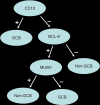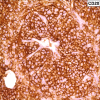Primary diffuse large B-cell lymphoma of the oral cavity: germinal center classification
- PMID: 20533006
- PMCID: PMC2923304
- DOI: 10.1007/s12105-010-0184-4
Primary diffuse large B-cell lymphoma of the oral cavity: germinal center classification
Abstract
Primary lymphomas of the oral cavity are rare and the most frequent type is diffuse large B-cell lymphoma (DLBCL). Recently, several reports have highlighted the value of classifying DLBCL into prognostically important subgroups, namely germinal center B-cell like (GCB) and non-germinal center B-cell like (non-GCB) lymphomas based on gene expression profiles and by immunohistochemical expression of CD10, BCL6 and MUM-1. GCB lymphomas tend to exhibit a better prognosis than non-GCB lymphomas. Studies validating this classification have been done for DLBCL of the breast, CNS, testes and GI tract. Therefore we undertook this study to examine if primary oral DLBCLs reflect this trend. We identified 13 cases (age range 38-91 years) from our archives dating from 2003-09. IHC was performed using antibodies against germinal center markers (CD10, BCL6), activated B-cell markers (MUM1, BCL2) and Ki-67 (proliferation marker). Cases were sub-classified as GCB subgroup if CD10 and/or BCL6 were positive and MUM-1, was negative and as non-GCB subgroup if CD10 was negative and MUM-1 was positive. Immunoreactivity was noted in 2/13 cases for CD10, in 12/13 for BCL6, in 8/13 for MUM-1, and in 6/13 for BCL2. Therefore, 8/13 (58%) were sub-classified as non-GCB DLBCLs and 5/13 (42%) as GCB subgroup. All tumors showed frequent labeling with Ki-67 (range 40-95%). Four of the 8 patients with non-GCB subgroup succumbed to their disease, with the mean survival rate of 16 months. Two patients in this group are alive, one with no evidence of disease and another with disease. No information was available for the other 3 patients in this group. Four of the 5 patients in the GCB subgroup were alive with no evidence of disease and one patient succumbed to complications of therapy and recurrent disease after 18 months. In conclusion, our analysis shows that primary oral DLBCL predominantly belongs to the non-GCB subgroup, which tends to exhibit a poorer prognosis. These findings could allow pathologists to provide a more accurate insight into the potential aggressive behavior and poorer prognosis of these lymphomas.
Figures







Similar articles
-
Expression of HGAL in primary cutaneous large B-cell lymphomas: evidence for germinal center derivation of primary cutaneous follicular lymphoma.Mod Pathol. 2008 Jun;21(6):653-9. doi: 10.1038/modpathol.2008.30. Epub 2008 Feb 8. Mod Pathol. 2008. PMID: 18264083
-
[Subgrouping and outcome prediction of diffuse large B-cell lymphoma by immunohistochemistry].Zhonghua Bing Li Xue Za Zhi. 2007 Oct;36(10):654-9. Zhonghua Bing Li Xue Za Zhi. 2007. PMID: 18194597 Chinese.
-
Evaluation of BCL-6, CD10, CD138 and MUM-1 expression in diffuse large B-cell lymphoma patients: CD138 is a marker of poor prognosis.Asian Pac J Cancer Prev. 2012;13(7):3037-46. doi: 10.7314/apjcp.2012.13.7.3037. Asian Pac J Cancer Prev. 2012. PMID: 22994707
-
Clinicopathologic and mutational profiles of primary breast diffuse large B cell lymphoma in a male patient: case report and literature review.World J Surg Oncol. 2023 Oct 26;21(1):342. doi: 10.1186/s12957-023-03234-z. World J Surg Oncol. 2023. PMID: 37884941 Free PMC article. Review.
-
The biology of human lymphoid malignancies revealed by gene expression profiling.Adv Immunol. 2005;87:163-208. doi: 10.1016/S0065-2776(05)87005-1. Adv Immunol. 2005. PMID: 16102574 Free PMC article. Review.
Cited by
-
Use of Liquid-based Cytology and Cell Block Combined Technique for an Accurate Diagnosis of Oral Diffuse Large B Cell Lymphoma: A Case Report.Diagnostics (Basel). 2020 Oct 14;10(10):823. doi: 10.3390/diagnostics10100823. Diagnostics (Basel). 2020. PMID: 33066681 Free PMC article.
-
Primary diffuse large B-cell lymphoma in the maxilla: A case report.Medicine (Baltimore). 2018 May;97(20):e10707. doi: 10.1097/MD.0000000000010707. Medicine (Baltimore). 2018. PMID: 29768336 Free PMC article.
-
Extra-nodal Diffuse Large B-cell Lymphoma (Germinal Center Type) Manifesting as Non-healing Extraction Socket.J Clin Diagn Res. 2016 Aug;10(8):ZD05-7. doi: 10.7860/JCDR/2016/18400.8226. Epub 2016 Aug 1. J Clin Diagn Res. 2016. PMID: 27656575 Free PMC article.
-
Extranodal diffuse large B cell lymphoma of maxillary sinus presenting as a palatal ulcer.BMJ Case Rep. 2019 Feb 9;12(2):e228605. doi: 10.1136/bcr-2018-228605. BMJ Case Rep. 2019. PMID: 30739092 Free PMC article.
-
Oral Manifestation of Lymphomatoid Granulomatosis.Head Neck Pathol. 2019 Jun;13(2):270-276. doi: 10.1007/s12105-018-0910-x. Epub 2018 Mar 14. Head Neck Pathol. 2019. PMID: 29542064 Free PMC article.
References
-
- Swerdlow SH, Campo E, Harris NL, Jaffe ES, Pileri SA, Stein H, et al. WHO Classification of Tumours of Haematopoietic and Lymphoid Tissues. 4. Lyon: IARC Press; 2008.
-
- Kolokotronis A, Konstantinou N, Christakis I, Papadimitriou P, Matiakis A, Zaraboukas T, et al. Localized B-cell non-Hodgkin’s lymphoma of oral cavity and maxillofacial region: a clinical study. Oral Surg Oral Med Oral Pathol Oral Radiol Endod. 2005;99(3):303–310. doi: 10.1016/j.tripleo.2004.03.028. - DOI - PubMed
Publication types
MeSH terms
Substances
LinkOut - more resources
Full Text Sources
Medical

